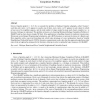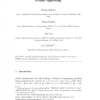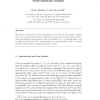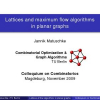COLOGNETWENTE
2010
13 years 12 months ago
2010
Given a bipartite graph G = (S, T, E), we consider the problem of finding k bipartite subgraphs, called "clusters", such that each vertex i of S appears in exactly one o...
COLOGNETWENTE
2010
14 years 1 months ago
2010
COLOGNETWENTE
2010
14 years 1 months ago
2010
An interval total t coloring of a graph G is a total coloring of with colors 1, such that at least one vertex or edge of is colored by color − G 2, ,t… G , 1, 2, ,i i t= … ,...
COLOGNETWENTE
2010
14 years 1 months ago
2010
Bisimplicial edges in bipartite graphs are closely related to pivots in Gaussian elimination that avoid turning zeroes into non-zeroes. We present a new deterministic algorithm to...
COLOGNETWENTE
2010
14 years 1 months ago
2010
COLOGNETWENTE
2010
14 years 1 months ago
2010
In this paper we analyze O’Hara’s partition bijection. We present three type of results. First, we show that O’Hara’s bijection can be viewed geometrically as a certain sci...
COLOGNETWENTE
2010
14 years 1 months ago
2010
We present an algorithm for the independent set problem on semi-random graphs, which are generated as follows: An adversary chooses an n-vertex graph, and then each edge is flipp...
COLOGNETWENTE
2010
14 years 1 months ago
2010




